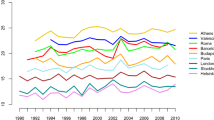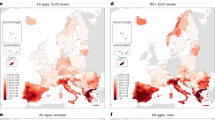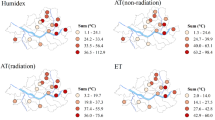Abstract
Hourly temperature and dew point from Las Vegas were collected and used to estimate the heat index and excess heat factor. The indices were used with data of heat-related deaths to assess the effect of extreme heat on the population. The trends of the heat indices were analyzed for 2007–2016, and the correlation between heat wave episodes and the number of heat-related deaths was estimated. Both indices showed a clear increase over the last ten years in the severity and number of heat wave events per year. The number of heat wave episodes increased, while their duration decreased. The number of heat-related deaths was also found to increase, with 2016 having the highest number of heat-related deaths. For the period, 437 heat-related deaths were registered in Las Vegas. The most vulnerable subpopulation was people over 50 years old, for which 76% of the heat-related deaths were associated with preexisting heart disease.









Similar content being viewed by others
References
Abdullahi MG, Kandar MZB, Wah LY, Usman AJ (2016) Perspectives on heat index and climate change on thermal comfort and human health. Int J Sci Res Sci Eng Technol 2(4):7–14
Allen MJ, Sheridan SC (2016) Spatio-temporal changes in heat waves and cold spells: an analysis of 55 U.S. cities. Phys Geogr 37:189–209
Allen MJ, Sheridan SC (2018) Mortality risks during extreme temperature events (ETEs) using a distributed lag non-linear model. Int J Biometeorol 62(1):57–67
Anderson GB, Bell ML, Peng RD (2013) Methods to calculate the heat index as an exposure metric in environmental health research. Environ Health Perspect 121:1111
Basu R, Samet JM (2002) Relation between elevated ambient temperature and mortality: a review of the epidemiologic evidence. Epidemiol Rev 24:190–202
Batson CD, Monnat SM (2015) Distress in the desert: neighborhood disorders, resident satisfaction, and quality of life during the Las Vegas foreclosure crisis. Urban Aff Rev 51:205–238
Berko J, Ingram DD, Saha S, Parker JD (2014) Deaths attributed to heat, cold, and other weather events in the United States, 2006–2010. National Health Statistics Reports, 76, Hyattsville
Black A, Stephen H (2014) Relating temperature trends to the normalized difference vegetation index in Las Vegas. GI Sci Remote Sens 51:468–482
Brelsford C, Abbott J (2017) Growing into water conservation? decomposing the drivers of reduced water consumption in Las Vegas, NV. Ecol Econ 133:99–110
Fischer EM, Schar C (2009) Future changes in daily processes and role for temperature extremes. Clim Dyn 33:917–935
Gubernot DM, Anderson GB, Hunting KL (2015) Characterizing occupational heat-related mortality in the United States, 2000–2010: an analysis using the census of fatal occupational injuries database. Am J Ind Med 58:203–211
Guirguis K, Gershunov G, Tardy A, Basu R (2014) The impact of recent heat waves on human health in California. J Appl Meteorol Clim 53:3–19
Guirguis K, Basu R, Al-Delaimy WK, Benmarhnia T, Clemesha RES, Corcos I, Guzman-Molares J, Hailey B, Small I, Tardy A, Vashishtha D, Zivin JG, Gerhunov A (2018) Heat, disparities, and health outcomes in San Diego County’s diverse climate zones. GeoHealth 2:212–223
Hass AL, Ellis KN, Mason LR, Hathaway JM, Howe DA (2016) Heat and humidity in the city: neighborhood heat index variability in a mid-sized city in the Southeastern United States. Int J Environ Res Pub Health 13:117
Hatvani-Kovacs G, Belusko M, Pockett J, Boland J (2015) Can the excess heat factor indicate heatwave-related morbidity? A case study in Adelaide, South Australia. EcoHealth. https://doi.org/10.1007/s10393-015-1085-5
Huntra P, Keener TC (2017) Evaluating the impact of meteorological factors on water demand in the Las Vegas Valley using time-series analysis 1990–2014. ISPRS Int J Geo-Info 6:249
Jones B, O’neil BC, McDaniel L, McGuinnis S, Mearns LO, Tebaldi C (2015) Future population exposure to US heat extremes. Nat Clim Change 5:625–655
Jones H, Trtanj J, Pulwarty RS, Higgins W (2016) The National Integrated Heat Health Information System (NIHHIS) as learning system for extreme heat: Evolving future resilience from present climate extremes. AGU Proceedings. AGU, 2016 FMGC51G, San Francisco
Kamal S, Huang HP, Myint SW (2015) The influence of urbanization on the climate of the Las Vegas area: a numerical study. Appl Meteorol Climatol 54:2157–2177
Kingsley SL, Eliot MN, Gold J, Vanderslice RR, Wellenius GA (2016) Current and projected heat-related morbidity and mortality in Rhode Island. Environ Health Perspect 124:460–467
Langlois N, Herbst J, Mason K, Nairn JR, Byard RW (2013) Using the excess heat factor (EHF) to predict the risk of hear related deaths. J Forensic Leg Med 20:408–411
Lee J, Byun H, Kim D (2016) Development of accumulated heat stress index based on time-weighted function. Theor Appl Climatol 124:541–554
Li M, Gu S, Yang J, Liu Q (2015) Heat waves and morbidity: current knowledge and further direction-a comprehensive literature review. Int J Environ Res Pub Health 12:5256–5283
Loridan T, Coates L, Agueso D, Perkins-Kirkpatrick S, McAneney J (2016) The excess heat factor as a metric for heat-related fatalities: defining heatwave risk categories. Aust J Emerg Manage 31:31–37
Luber G, McGeehin M (2008) Climate change and extreme heat events. Am J Prev Med 35:429–435
Martinez-Austria PF, Bandala ER (2017) Temperature and heat-related mortality trends in the Sonoran and Mojave Desert region. Atmosphere 8:53–65
Martinez-Austria PF, Bandala ER, Patino-Gomez C (2016) Temperature and heat wave trends in northwest Mexico. Phys Chem Earth 91:20–26
Medical Examiners’ and Coroners’ Handbook on Death Registration and Fetal Death Reporting (2003) Prevention, Centers for Disease Control. National Center of Health Statistics, Hyattsville
Meehl GA, Tebaldi C (2004) More intense, more frequent and longer lasting heat waves in the 21st century. Science 305:994–997
Meehl GA, Tebaldi C, Adams-Smith D (2016) US daily temperature records past, present, and future. Proc Nat Acad Sci 113(49):13977–13982
Myint SW, Zheng B, Talen E, Fan C, Kaplan S, Middel A, Smith M, Huang H, Brazel A (2015) Does the spatial arrangement of urban landscape matter? Examples of urban warming and cooling in Phoenix and Las Vegas. Ecosyst Health Sustain 1:1–15
Nairn JR, Fawcett RJB (2015) The excess heat factor: a metric to heat wave intensity and its use in classifying heat wave severity. Int J Environ Res Publ Health 12:227–253
NOAA (2016). http://www.wpc.ncep.noaa.gov/html/heatindex.shtml. Accessed March 2017
NOAA (2017). https://www.ncdc.noaa.gov/IPS/lcd/lcd.html;jsessionid=43415E235F83DAB8A66DBA2DBC9DDA27?_page=0&state=NV&_target1=Next+%3E#DESCRIPTION. Accessed August 2017
Opitz-Stapleton S, Sabbag L, Hawley K, Tran P, Hoang L, Hoang P (2016) Heat index trends and climate change implications for occupational heat exposure. Clim Serv 2–3:41–51
Palecki MA, Changnon SA, Kunkel KE (2001) The nature and impacts of the July 1999 heat wave in the midwestern United States: Learning from the lessons of 1995. Bull Am Meteorol Soc 82(7):1353–1368
Perkins SE, Alexander LV, Nairn JR (2012) Increasing frequency, intensity and duration of observed global heatwaves and warm spells. Geophys Res Lett 39:L20714
Petkova EP, Gasparrini A, Kineey PL (2014) Heat and mortality in New York City since the beginning of the 20th Century. Epidemiology 25:554–560
Pharr J, Coughenour C, Gerstenberg S (2015) Demographic makeup and population projections for Southern Nevada: understanding the emerging healthcare needs in our community. Nev J Publ Health 11:23–36
Ramirez-Beltran ND, Gonzalez JE, Castro JM, Angeles M, Harmsen EW, Salazar CM (2017) Analysis of the heat index in the Mesoamerica and Caribbean region. J Appl Meteorol Climatol 56:2905–2925
Raymond C, Singh D, Horton RM (2017) Spatiotemporal patterns and synoptics of extreme wet-bulb temperature in the contiguous United States. J Geophys Res Atmos 122:108–124
Reich BJ, Shaby BA, Colley D (2014) A hierarchical model for serially-dependent extremes: a study of heat waves in the western US. J Agric Biol Environ Stat 19(1):119–135
Riley K, Wilhalme H, Delp L, Eisenman DP (2018) Mortality and Morbidity during extreme heat events and prevalence of outdoor work: an analysis of community-level data from Los Angeles County, California. Int J Environ Res Public Health 15(4):580
Schubert SD, Wang H, Koster RD, Suarez MJ, Groisman PY (2014) Northern Eurasian heat waves and droughts. J Clim 27:3169–3207
Seager R, Vecchi GA (2010) Greenhouse warming and the 21st century hydroclimate of southwestern North America. Proc Nat Acad Sci 107:21277–21282
Sokolowsky A, Marquez E, Sheehy E, Barber C, Gerstenberger S (2017) Health hazards in the home: an assessment of a southern Nevada community. J Comm Health 42:730–738
Stephen H, Black A, Ahmad S (2014) Relating temperature trends to urban change and NDVI in Las Vegas. Portland, OR. In: World Environmental Water Resource, pp 866–875
Taylor EV, Vaidyanathan A, Flanders WD, Murphy M, Spencer M, Noe RS (2018) Differences in heat-related mortality by citizenship status: United States, 2005–2014. Am J Pub Health 108(S2):S131–S136
Thakali R, Karla A, Ahmad S (2016) Understanding the effects of climate change on urban stormwater infrastructure in the Las Vegas Valley. Hydrology 3:34–50
Tong STY, Yang H, Chen H, Yang JY (2016) Hydrologic impacts of climate change and urbanization in the Las Vegas Wash watershed, Nevada. J Water Clim Change 7:598–620
Warren EL, Young DT, Chapman L, Muller C, Grimmond CSB, Cai XM (2016) The Birmingham urban climate laboratory—A high density, urban meteorological dataset, from 2012–2014. Sci Data 3:160038
Wehner M, Stone D, Krishan H, Achuta RK, Castillo F (2015) The deadly combination of heat and humidity in India and Pakistan in summer 2015. Bull Am Meteorol Soc 97:S81–S86
Williams MD, Goodrick SL, Grundstein A, Shepherd M (2015) Comparison of dew point temperature estimation methods in Southwestern Georgia. Phys Geogr 36:255–267
World Health Organization (2011) International statistical classification of diseases and related health problems. World Health Organization, Geneva
Acknowledgements
This material is based upon work supported in part by the National Science Foundation (Grant IIA-1301726). The authors thank the Clark County Coroner/Medical Examiner Office for providing information for heat-related deaths. J. Mejia thanks NASA (Grant NNX12AF57G) and DRI for their support in developing this manuscript. The authors also thank Ms. Nicole Damon (DRI) for her editorial review.
Author information
Authors and Affiliations
Corresponding author
Additional information
Editorial Responsibiility: Zhenyao Shen.
Electronic supplementary material
Below is the link to the electronic supplementary material.
Rights and permissions
About this article
Cite this article
Bandala, E.R., Kebede, K., Jonsson, N. et al. Extreme heat and mortality rates in Las Vegas, Nevada: inter-annual variations and thresholds. Int. J. Environ. Sci. Technol. 16, 7175–7186 (2019). https://doi.org/10.1007/s13762-019-02357-9
Received:
Revised:
Accepted:
Published:
Issue Date:
DOI: https://doi.org/10.1007/s13762-019-02357-9




